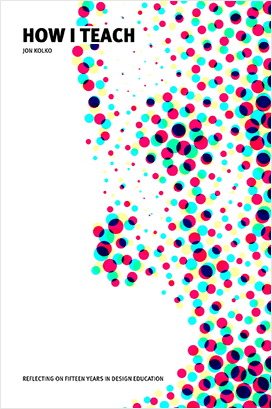
This is from 2015 | 5 minute read
Teaching a Confidence in Process
The design process always performs. Following the broad design process always results in new ideas, grounded in both the reality of a problem space and the tacit knowledge of the designer. But there's no guarantee that the ideas are any good, and in many ways, this presents a challenge for students of design.
On the one hand, as students learn the process of ethnographic research, synthesis, ideation, and storytelling, they start to make things. That's powerful, and it feels good—for many people, this is the first time their ideas are taken seriously, because it's the first time their ideas have been given form other than language. When an idea has form, it becomes real. People can respond to it, can argue with and about it, can critique it, and can be offended by it. Students realize that power quickly (often the first time they show their work to someone else). As students gain ability with craftsmanship, the fidelity of their idea improves, and as that fidelity increases, criticism shifts. Audiences stop focusing on and critiquing the manner in which the idea is presented (I don't believe that this idea is real) and can start to critique the idea itself (I don't think this idea should be real).
On the other hand, as students begin to make things, they begin to realize the fragility of their ideas. New ideas are like crocuses growing in the ground: so full of potential, but so easy to crush. The high fidelity in which the idea is sketched can be misleading: If the idea appears real, it indicates a sense of creative confidence. "This idea is bulletproof," it says, "so go ahead and critique it—I can defend every bit of it."
In reality, creativity (and particularly, innovation) is often indefensible. As author Edward DeBono notes, "The problem is this: Every valuable, creative idea will always be logical in hindsight. If an idea were not logical in hindsight, then we would never be able to appreciate the value of the idea." But before there can be hindsight there must be the present, and in those early moments a new design idea is rarely logical. Students have connected dots with their informed intuition and made leaps between facts to get to a new, provocative reality. The idea hasn't had a chance to mature, and so those connections are poorly understood, even by the designer herself. And so a new idea does not hold up to criticism and can be easily trivialized. An experienced designer understands this, at least intuitively, and has typically learned to frame criticism as suggestions rather than as mandates.
Consider how this plays out during a pitch or a critique, as a skeptical audience member responds to a new idea with "That's not how it's done now; I just don't understand how that could work. There's no way people would try that." An experienced practitioner might say something like, "It's a great point—people are used to an existing process, and this new idea would need to be introduced into the market gradually. But I'm confident that we can work through that concern with further iterations of the idea; here are some thoughts we had about that." But a design student might get defensive, or worse, shut down completely. They don't necessarily see an iterative future for the idea—they think of it as a static, fixed vision. As students internalize negative critique, with their tail between their legs, they often talk themselves into the impossibility of the success of their idea. Additionally, students learn to avoid criticism or feedback about ideas at this stage in the process. Yet it's precisely at this point where criticism is most effective and can be most instrumental. Worst of all, in the face of criticism, students often discount the entire process that got them to their solution in the first place.
I've found that the way around this problem is to help students find personal satisfaction in their process rather than their idea. Students connect their personal fulfillment and sense of worth with the work that goes into coming up with creative solutions; they learn to celebrate the process, and in doing so, they realize that ideas are free. "Having an idea" becomes second nature—just follow the process. Since having ideas becomes automatic and implied, design students can spend time learning iteration and can continue to work through the idea details in the face of criticism by integrating (or selectively ignoring) feedback. The idea becomes better, more refined, and more defensible. And as the idea matures, criticism of the idea begins to match the fidelity of the vision. That marriage of feedback and idea can live in harmony through a product launch or pilot test. It stops being an all-or-nothing question, and the design itself, rather than just the idea of the design, becomes real.
This is a confidence in process, rather than a confidence in artifact. To formalize this in an educational curriculum requires shifting focus from the craftsmanship of the things students make to the richness of the process they leverage.
